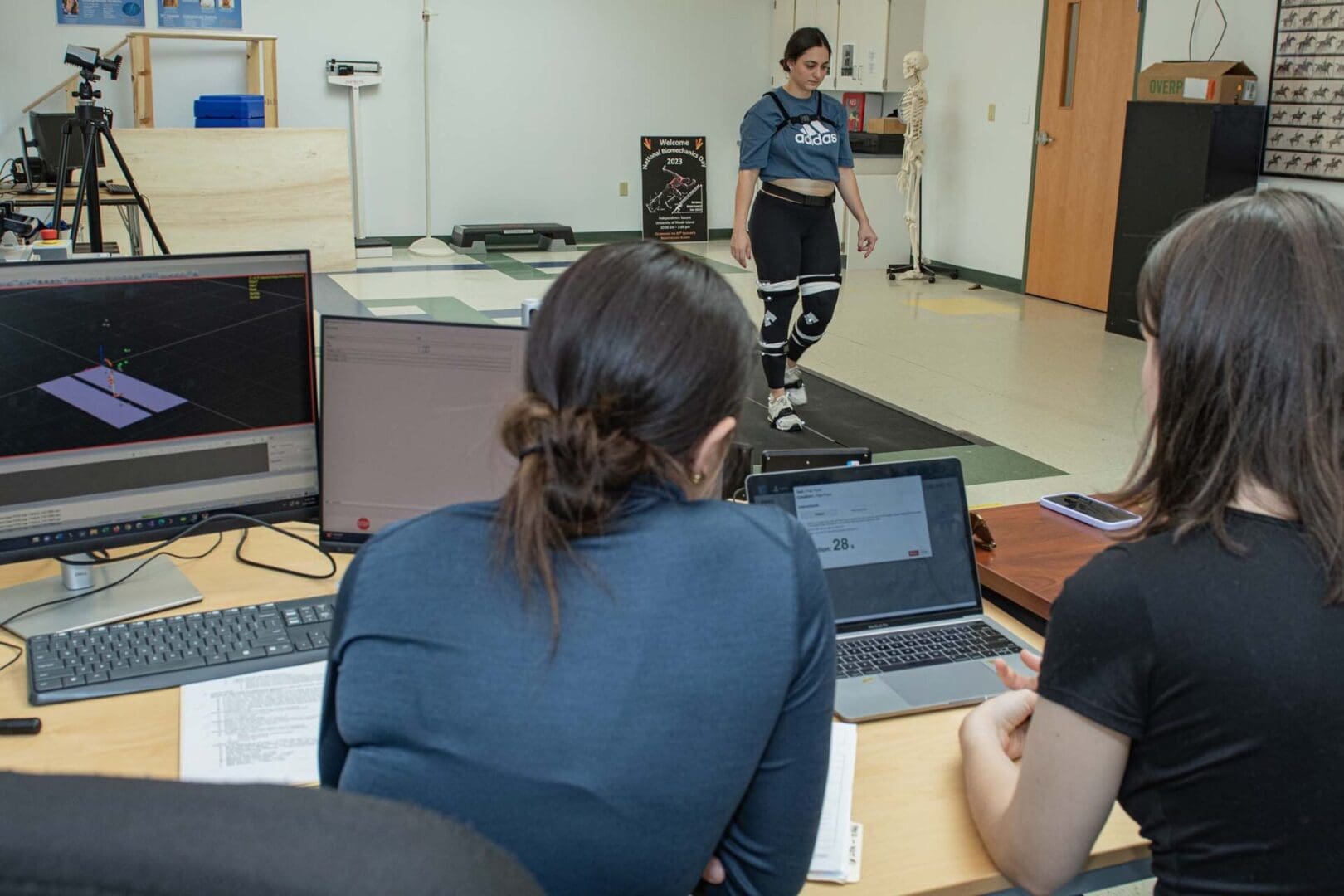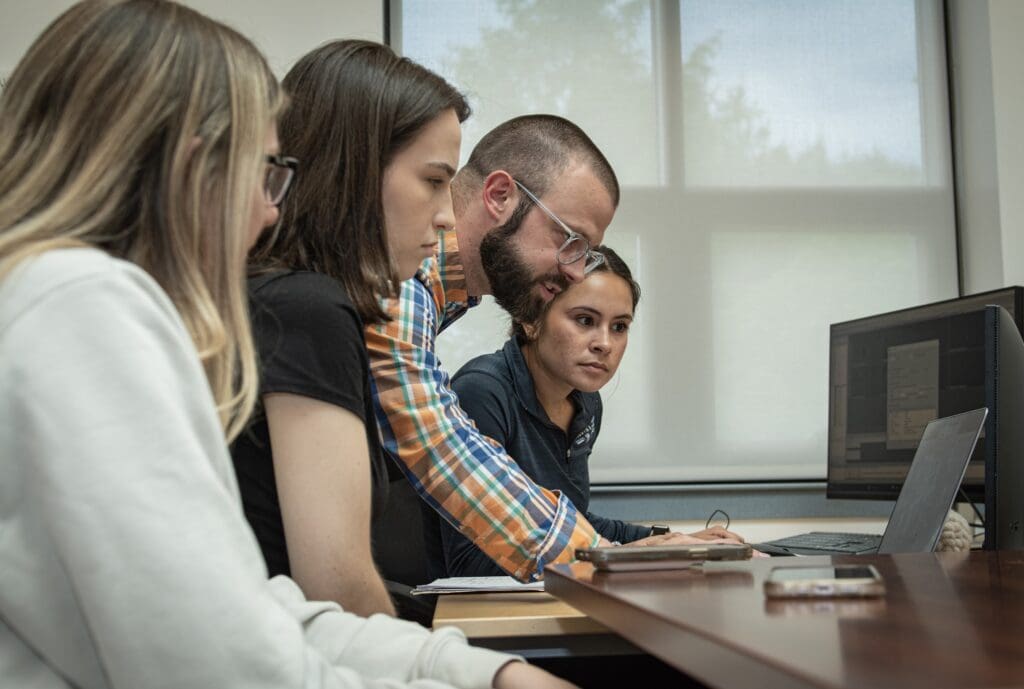Search Posts
Recent Posts
- Rhode Island Weather for May 5, 2024 – John Donnelly May 5, 2024
- Honoring 154 new Eagle Scouts May 5, 2024
- Gimme’ Shelter: Meet John at the Providence Animal Control Center May 5, 2024
- Ask Chef Walter: Mastering Asparagus – Chef Walter Potenza May 5, 2024
- Green Animals Topiary Garden sets its annual plant sale May 5, 2024
Categories
Subscribe!
Thanks for subscribing! Please check your email for further instructions.

URI studies Biomechanics and Pregnancy to improve prenatal care, reduce maternal death
Kinesiology Professor Ryan Chapman’s team investigates the impact of pelvic and lower extremity biomechanics on labor and delivery outcomes
Photo, above: Kinesiology students Olivia Greene and Meghan Whelan work in the Motional Analysis Lab with an expectant mother who volunteered for the study.
In a potentially groundbreaking research project, University of Rhode Island Kinesiology Professor Ryan Chapman is leading a study focused on exploring the role of biomechanics during pregnancy and its influence on labor and outcomes. The pioneering study has the potential to improve maternal care and reduce the persistently high maternal mortality rates in the United States.
Inspired by the challenging birth of his own child, Chapman aimed to better understand the biomechanics involved in the birthing process and its implications for mothers and newborns. By studying how the pelvis and lower extremities change biomechanically in preparation for labor and delivery, the research aims to identify the biomechanics factors contributing to prolonged labor and its associated risks, including maternal hemorrhaging, which is closely linked to maternal mortality.
“My son was delivered safely, thankfully, but how did that happen? My wife had no major problems throughout the pregnancy, and then at the end, the labor was long and complicated,” Chapman said. “So I started thinking, how do we safely deliver a baby? Really, that is a biomechanics question… can the fetus fit down the birth canal and safely out for a vaginal delivery? The pelvis needs to change for that to occur, but if the pelvis does not change, what are the implications for mothers and their newborns? The risk, it turns out, is prolonged labor. And on of the biggest concerns with prolonged labor is hemorrhaging, which is strongly linked with maternal mortality.”
The United States, despite its advanced healthcare system, has seen elevated rates of maternal mortality compared to other developed countries. With the current rate at 33 maternal deaths per 100,000 live births—up from 24 in 2020 and 12 from 1990—the U.S. lags behind countries like Canada and Germany, which report rates as low as 8.4 and 3.2 per 100,000 live births, respectively. Chapman, working with master’s candidate Olivia Greene and URI undergraduate research award recipient Meghan Whalen, aims to shed light on the relationship between changes in pelvic and lower extremity biomechanics during pregnancy, and both maternal mortality and newborn outcomes.
By monitoring lower extremity and pelvic motion of pregnant women during everyday activities such as walking and climbing stairs, the team aims to determine how lower extremity biomechanics evolve throughout pregnancy. The valuable data will be collected at various times during pregnancy and the postpartum period, providing insights into the connection between these biomechanical variations and the labor and delivery process.
To achieve these goals, the study utilizes state-of-the-art techniques, including an optical motion capture system, wearable motion sensors, and electromyography (EMG). By capturing precise information about joint movement, force and neuromuscular activity, the team aims to develop a cost-effective and non-invasive technology capable of remotely monitoring pregnant individuals from their own homes. This innovative monitoring system could play a pivotal role in identifying those in need of additional support and intervention during labor and delivery, while also providing peace of mind to individuals with typical biomechanical changes.

“Right now, we don’t know a lot about what changes biomechanically during pregnancy. Some studies have found pregnant mothers tend to walk differently or have different levels of back pain during pregnancy,” Chapman said. “Those studies don’t make the connection to outcomes. Are those differences in walking connected to poor or positive outcomes? And can we monitor that and know ahead of time that early interventions are needed? This study has the possibility to really influence maternal care and help save expectant mothers.”
Chapman’s team has begun recruiting pregnant women and is actively collaborating with clinical professionals across Rhode Island and Connecticut to expand the participant pool. Control subjects, comprising young individuals aged 18 to 35 who have never had a child and are not currently pregnant, serve as a baseline for comparison. Any expectant mothers interested in taking part in the study are urged to contact Chapman at [email protected].
